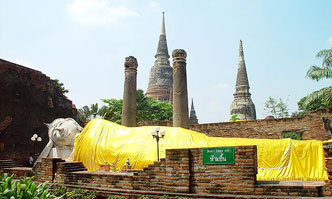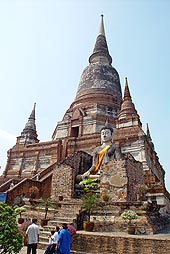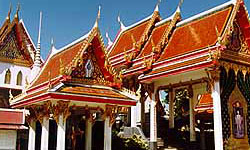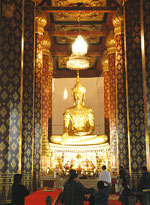The Phra Nakhon Si Ayutthaya or Ayutthaya in short, is one of Thailand's historical and majestic highlights. Serving as the Thai capital for 417 years (1350 1767: Kingdom of Ayutthaya), it was once glorified as one of the biggest cities in Southeast Asia.

Ayutthaya was founded around A.D.1350 by a Prince of U-Thong. It used to be one of the richest cities in Asia by the 1600s, exporting rice, animal skins, ivory, etc. In 1767 the city was completely burned during the war.
The Kingdom of Ayutthaya reached its apex in terms of sovereignty, military might, wealth, culture, and international commerce in the 16th century when the Kingdoms territory was extended far beyond present-day Laos, Cambodia, and Myanmar. Ayutthaya even had diplomatic relations with Louis XIV of France and was courted by Dutch, Portuguese, English, Chinese and Japanese merchants.
Visitors can explore and appreciate Thai history in Phra Nakhon Si Ayutthaya, which is situated only 86 kilometers north of Bangkok. Visitors to Ayutthaya can marvel at its grandeur reflected through numerous magnificent structures and ruins concentrated in and around the city island surrounded by Maenam Chao Phraya, Maenam Pa Sak and Maenam Lopburi.
More importantly,Phra Nakhon Si Ayutthaya Historical Park, an extensive historical site in the heart of Ayutthaya city, has been included in UNESCO's World Heritage list since 13 December, 1991.
The Past
The Kingdom of Ayutthaya was built and developed in leaps and bounds. The ruins in Ayutthaya that survived the test of time embody both the glorious and ignominious stories of the Kingdom.
This ancient capital of the Kingdom of Ayutthaya, founded in 1350 by King U-Thong, had thirty three kings of different dynasties and reached its peak in the middle of the18th century. A magnificent city with three palaces and over 400 magnificent temples on an island threaded by canals Ayutthaya was truly an impressive city that attracted both Europeans and Asians. After a 15-month siege the Kingdom of Ayutthaya was conquered and completely destroyed by the Burmese in 1767. When King Taksin the Great finally liberated the Kingdom, a new dynasty was established and the capital was moved to Thonburi.
The seal of Ayutthaya depicts a conch on a pedestal tray placed in a small castle under a Mun tree. According to legend, King U-Thong, founder of the Kingdom of Ayutthaya, discovered a beautiful conch buried in the ground being prepared for the establishment of the seat of his Kingdom. Consequently, he had a tiny castle built to house the shell. Hence, the provincial seal.
The Present
Today, there are but groups of crumbling ruins and rows of headless Buddhas where once an empire thrived. The temple compounds are still awe-inspiring even in disrepair and a visit here is memorable and a good beginning for those drawn to the relics of history.
The architecture of Ayutthaya is a fascinating mix of Khmer (ancient Cambodian style) and early Sukhothai style. Some cactus-shaped obelisks, called prangs, denote Khmer influence and look something like the famous towers of Angkor Wat. The more pointed stupas are ascribed to the Sukhothai influence. For new arrivals who had limited their visit to Bangkok, similarities may be noted with the riverside Wat Arun, an 18th-century structure that was built in the so-called Ayutthaya style, a melding of Sukhothai Buddhist influences and Hindu-inspired Khmer motifs.

Wat Yai Chai Mongkol
Wat Yai Chai Mongkol is situated to the southeast and opposite to Ayutthaya city. A large Chedi of this Wat can be seen from a far distance. This monastery was built by King U-Thong in 1357 A.D. for the use of the monks who had returned from Ceylon after studying under Phra Vanarat Maha Thera.

Wat Panan Choeng
Wat Panan Choeng is an old monastery housing Thailand's largest ancient Buddha image, known as "Luang Po To". A historical cronicle states that this gilded stucco image was built in A.D.1344, some 26 years before the establishment of Ayutthaya as the capital of the Thai Kingdom in A.D.1350.
Wat Maheyong
Wat Maheyong is located in the opposite direction of Wat Yai Chai Mongkol. The restoration work had been done and upon our visit on June 24, 2001, this temple is much more attractive. The parking lot for tourist is provided, while the compound is nicely improved. The main large chapel is restored and some Buddha images are installed.
Wat Suwandararam
Wat Suwandararam was built in the end of Ayutthaya Period, during 2275 - 2301 B.E., formerly named Wat Thong. It was destroyed during the war and left unattended until in 2328 B.E. when it was restored and rebuilt and named Wat Suwandararam Ratchaworaviharn until now. The mural paintings inside the chapel (Ubosot) and inside the Vihara are famous and they describe the story of the Lord Buddha and King Naresuan the Great and part of Ayutthaya history.
Phra Chedi Sri Suriyothai
Phra Chedi Sisuriyothai is the memorial to Somdet Phra Sisuriyothai, the Thai heroine in the Ayutthaya period. She was the queen of Somdet Phra Mahajakrapat, the king of Ayutthaya which reigned when he was 36.
After King Somdet Phra Mahajakrapat reigned in 1548 A.D. for 7 months, Phra Chao Tabengchaveti, the King of Burma, moved his troops to beat Ayutthaya to revenge for the former unsuccessful beat of Chiengkran town in the reign of King Chairajathirat.
In the first battle, King Somdet Phra Mahajakrapat would lead his troops with his two sons, Prince Phra Ramesuan and Prince Phra Mahintrathirat on elephants, but queen Somdet Phra Sisuriyothai was concerned for her husband then she disguised herself as a man in a fighting form and accompanied with them.
When the Ayutthaya's troops met the front Burmese troops, which was led by Phra Chao Phrae, King Somdet Phra Mahajakrapat rode his elephant to fight against Phra Chao Phrae, but his elephant was in collapse so Phra Chao Phrae raised his scythe to cut King Somdet Phra Mahajakrapat, queen Somdet Phra Sisuriyothai nearby had seen the event, she decided to save her husband by riding her elephant to intervene the fighting. She was killed by the scythe of Phra Chao Phrae on her elephant back. Then their two sons helped them and moved the corpse back.With her devotion, King Somdet Phra Mahajakrapat constructed a chedi, called Phra Chedi Sisuriyothai at Wat Suanluang Sobswan, Hualaem District.
Wat Chaiwatthanaram
Wat Chaiwatthanaram, one of the most imposing ancient Buddhist monasteries, was established by the command of King Prasatthong in 1630 A.D. It is believed that the wat is located on the site of his former home. The reason for building this monastery was to make merit for his mother. Prince Damrong Rachanuphap noted that its architecture was similar to that of Angkor Wat and inferred that the wat might have been built to commemorate the king's victory over Cambodia.
This wat consists of a main prang (Khmer-type tower) and four lesser prangs, all created on the same base ans surrounded by eight lesser prangs and a gallery.
Wat Na Phrameru Rachikaram
Oung-In in the reign of King Ramathibodi II, the tenth king of Ayutthaya, ordered the construction of this temple in 1499 A.D.

The temple was the place where the king of Thailand and the king of Burma agreed on the peace issue and as a witness they had brought the Buddha image, the holy book and monks there.
After that in 1760 A.D. the king of Burma had invaded Thailand and used this temple to place canons and fired them into the Royal Palace area. One of this shells hit a part of royal palace named Suriya Ammarin and destroyed it. During that war King Along Phya fired a canons by himself and one of the canons bursted out and he was seriously injured. He had to withdraw the troops and intended to go back to Burma, but he died at Tak border. Thus Wat Na Phrameru Rachikaram was the only temple not destroyed during the war with the Burmese.
Wat Phra Sri Sanphet
The royal palace was located here from the establishment of Ayutthaya in the reign of King Ramathibodi 1 (1350 A.D.) to the reign of King Sam Phraya (1448 A.D.). Later King Borommatrailokanat ordered a wat to be built on this site in 1448 A.D. to be used as a monastic area.
After the reign of King Borommatrailokanat, his son King Ramathibodi II, ordered the construction for two chedis, one of which was kept the ashes of his father and the other those of his brother, King Borom-marachathirat III. Another chedi was built by order of King Borom-rachanophuttangkun. It was similarly used to house royal remains those of King Ramathibodi II.
In 1499, a principal viharn was built. The following year, in 1500 A.D., King Ramathibodi II commanded the casting of a standing Buddha image 16 meters high and covered with gold. This image, Phra Buddha Chao Si Sanphet was the main object of veneration in the royal viranra (hall of worship). After that time the ashes of members of the royal family other than the kings were placed in small chedis constructed at the site. Wat Phra Si Sanphet was the royal chapel and as such did not have a Sangavasa (no monks dwelt there). It was used for royal ceremonies.
When Ayutthaya was sacked in 1767 A.D. the gold which covered was taken by the invaders. During his reign King Rama I (1782 -1809 A.D.) of the Ratanakosin Period ordered the transfer of the inner core of Phra Buddha Chao Si Sanphet from Ayutthaya to Wat Phra Chetuphon in Bangkok, and had it placed in a chedi specially built for the purpose. Another Buddha image of importance called Phralokanat was also brought to this wat at about the same time.
Wat Ratchburana
In 1424 A.D. King Intharachathirat passed away. His two sons, Chao Aye Phraya who reigned over Suphanburi, and Chao Yi Phraya who reignned over Sanburi, met in battle as each desired the throne. This took place at the approach to the Pa-Than bridge and ended with the death of both sons. A third son, Chao Sam Phraya came down from Phitsanulok and acceded to the throne where upon he declared his intention to organize a funeral for his father and his two brothers. Afterwards he ordered the building of a wat, namely Wat Ratchaburana, at the site of the cremation and at the place where his brothers fought and died. He has two chedis created in which to keep their ashed.
In September of 1957 A.D. looters dug into a two-level crypt inside the main prang (Khmer-type tower) and stole a great quantity of material. Police arrested some of these looters. The Fine Arts Department proceeded to excavate the site and found Buddha images and many artifacts made of gold. Among these were a large number of votive tablets made of gold and lead. In 1958 A.D. the Fine Arts Department built a stairway so that one could go down into the crypt and look at the paintings which were also found there. Since the Buddha images and votive tablets discovered in the crypt were very numerous, the ministers of the government approved giving some of them to people who had contributed to the building of the Chao Sam Phraya National Museum, much of the collection in which was found at Wat Ratchaburana.
Wat Mahathat
The construction of Wat Mahathat was begun during the reign of King Borommarachathirat 1 in 1374 A.D. but it was completed during the reign of King Ramesuan (1388-1396 A.D.). When King Songtham (1680-1628 A.D.) was in power the main prang (Khmer-style tower) collapsed. The restoration work on the prang was probably completed in the reign of King Prasartthong (1630-1655 A.D.). During the restoration the height of the prang was considerably increased.
Wat Mahathat was restored once again during the reign of King Borommakot (1732-1758 A.D.) when four porticos of the main prang were added. In 1767 A.D. when Ayutthaya was sacked the wat was burnt and has since then been in ruins.
Wat Mahathat was a royal monastery and has been the seat of the Sangaraja, the head of the Buddhist monks of the Kamavasi sect, since the time of the Mahathera Thammakanlayan, who was a contemporary of King Borommarachathirat 1, who built the wat.
During the reign of King Rama VI in the Rattanakosin period, about 1911 A.D., the main prang of the wat collapsed again and looters seized the opportunity to dig for treasure. Only in 1956 A.D. did the Fine Arts Department undertake excavations around the central area of the prang where the relics must have been kept. The relics of the Buddha were found in the stupa within a seven layer reliquary. Other antiquities were recovered as well, including Buddha images, votive tables, covered boxes shaped like fish and golden plaques in the form of animals. All these objects are now at the Chao Sam Phraya National Museum.
Wat Puthaisawan
This temple is located not far from the Portugese Village. The entrance leads to the statue of King Naresuan the Great and King Agatosarot where people come to play respect. Inside the temple, three Buddha images are located. According the the history during Ayutthaya period this temple was famous for its sword fighters training.



